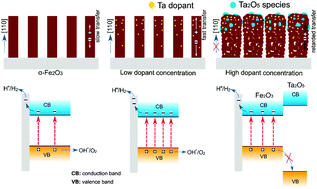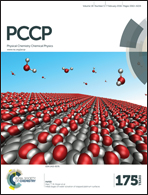Solution growth of Ta-doped hematite nanorods for efficient photoelectrochemical water splitting: a tradeoff between electronic structure and nanostructure evolution†
Abstract
Ta-doped hematite (α-Fe2O3) nanorod array films were successfully prepared on fluorine-doped tin dioxide (FTO) coated glass substrates via a facile solution growth process with TaCl5 as a Ta doping precursor. Under 1 sun illumination and at an applied potential of 1.0 V vs. Ag/AgCl, the Ta-doped α-Fe2O3 photoanode with optimized dopant concentration showed a photocurrent density as high as 0.53 mA cm−2, which was about 3.5 times higher than that of the undoped sample. As demonstrated by Mott–Schottky and X-ray absorption spectroscopy measurements, considerable increase in photoelectrochemical (PEC) performance achieved for Ta-doped α-Fe2O3 nanorod films should be mainly attributed to the increased electron donor density induced by Ta doping. However, with superfluous Ta doping, the [110]-oriented nanorod structure was destroyed, which caused greatly restrained photoinduced holes transferring to the surface and retarded surface water oxidation reaction, leading to decreased PEC water splitting activity. This study clearly demonstrated that doping could be effective to enhance the PEC activity of α-Fe2O3 nanorods as photoanodes, while it is of great necessity to balance the trade-off between the electronic structure and nanostructure evolution by optimizing the dopant concentration, for increased donor density and meanwhile with the nanorod nanostructure well preserved for directed charge transfer.

- This article is part of the themed collection: 2016 most accessed PCCP articles


 Please wait while we load your content...
Please wait while we load your content...